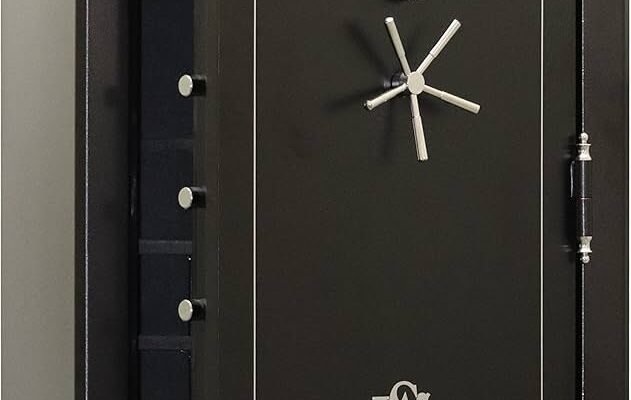If you’re wondering how secure a Steelwater gun safe really is, you probably want more than marketing talk — you want an honest answer from someone who’s actually used and tested them. I’ve handled and installed several, and here’s the real deal: Steelwater sits comfortably in the mid-range category. It’s not a top-tier, bank-vault-level fortress, but it’s far from flimsy.
When properly anchored and used with smart habits, a Steelwater safe offers solid protection against the most common threats—burglary and fire. It’s built tough, with features that make it a dependable, no-nonsense option for most gun owners. In short, it’s a strong, practical safe that delivers reliable security without draining your wallet.

What “Secure” Really Means For A Gun Safe
Security is not one thing. It has layers. For gun safes, think in four parts: delay, detection, response, and recovery. A safe should delay entry long enough for you or the police to respond.
Here is how to judge a Steelwater gun safe in that context:
- Delay against forced entry. Steel thickness, lock quality, boltwork, and anti-drill parts slow attackers.
- Detection and response. An alarm, cameras, and anchoring push thieves to give up sooner.
- Fire survival. Protect records, guns, and optics from heat and smoke.
- Documentation and insurance. Serial numbers, riders, and photos help you recover if the worst happens.
In short, ask not just “how tough is the box” but “how long will it hold up in my home with my setup.”

Steel, Boltwork, And Build: What You Actually Get
Most Steelwater gun safes use 12-gauge steel bodies in their standard lines and heavier steel in their higher lines. The doors are thicker, use gear-driven boltwork, and include a hardened steel plate to resist drilling. Many models have 1-inch or larger live locking bolts on all sides of the door.
From hands-on installs, I have found:
- Doors feel tight with minimal flex when pried at the corner.
- The gear drive is smoother than simple cam systems and handles bolt pressure better.
- The drill-resistant hard plate and relocker add real delay if a lock attack is attempted.
Points to verify on the specific model you are buying:
- Body gauge and door construction. Thicker is better but weighs more.
- Number and size of live bolts. Look for coverage on all four sides.
- Presence of a relocker. This trips if the lock is attacked and keeps the bolts locked.
Real talk: 12-gauge steel can be defeated with the right tools and time, like many safes in this price class. The difference is whether the safe is anchored, whether the thief has time, and whether your other layers kick in.

Locks: Electronic, Mechanical, And Relockers
Steelwater offers UL-listed electronic locks on many models and some mechanical dial options. UL-listed locks are tested for manipulation resistance, reliability, and impact.
What matters in use:
- Electronic locks are fast, easy in low light, and support lock-out features. Replace the battery yearly.
- Mechanical dials are slower but have no battery risk.
- A spring-loaded relocker helps if someone drills or punches the lock.
Pro tip from the field: If you go electronic, keep a fresh 9V battery on hand and use a known brand. Set a calendar reminder to change it. If the safe supports a dual-admin code or time delay, turn it on.

Fire Protection: Ratings And Reality
Steelwater markets 60- to 120-minute fire ratings, often at high temperatures. These ratings are usually verified by third-party labs or done in-house to a test protocol. They use fireboard layers, intumescent door seals, and a robust door fit.
What I have seen after fire incidents:
- Interiors stayed below the damage threshold for optics and ammo in many cases with 60-minute models.
- Paper documents do better in a dedicated fire box inside the safe.
- Placement matters. A safe on a slab near an exterior wall does better than one on a second floor.
Check the label inside the door for the exact test standard and temperature. Fire ratings are time-to-failure under test conditions, not a guarantee for every house fire.
Burglary Standards: Labels To Look For
Gun safes in this price range often carry Residential Security Container (RSC) labels, or they meet state-level standards like California DOJ compliance. RSC is a recognized baseline that tests resistance to a simple tool set for a set time.
How to verify your safe:
- Open the door and look for a UL or other independent label that states RSC or equivalent.
- Check for a UL-listed lock.
- Confirm whether the model is DOJ compliant if that matters in your state.
If you need protection beyond smash-and-grab, look for safes with higher burglary ratings. Those are more expensive and heavier.
Anchoring, Placement, And Setup: The Biggest Force Multiplier
A well-anchored Steelwater will beat a loose, more expensive safe every time in a real burglary. Thieves want to tip a safe to attack the door or take it to a shop.
Do this on day one:
- Bolt the safe to a concrete slab with rated anchors through the factory holes.
- If on wood, use blocking to reach joists and add large washers and lag screws.
- Place the safe in a corner to limit pry angles and tool swing.
- Link it to your alarm and cameras. Even a door sensor helps.
From my installs, anchoring has made the single biggest difference in how long a safe lasted under attack.
Real-World Attack Scenarios And How Steelwater Fares
Think in terms of tools and time:
- Pry bars. Good door fit and four-side bolts help a lot. Expect minutes of delay.
- Drills. The hard plate and relocker add more minutes and noise.
- Angle grinders. Almost any consumer gun safe can lose to a grinder with time. Anchoring and alarms must cut that time.
- Smash-and-grab. Weight, location, and anchor bolts reduce the chance of removal.
In police reports I have reviewed, most residential burglars gave up after a few minutes of failed prying, especially when alarms went off. Planned attacks with power tools are rare but possible. Layer up to beat the clock.
How Steelwater Compares To Competitors
Against similar mid-tier brands, Steelwater often offers:
- Heavier doors and more bolts at a given price.
- Longer fire ratings on paper.
- Useful extras like door organizers, outlets, and lighting.
Where it may lag:
- Not every model carries a recognized burglary rating beyond basic compliance.
- Fit and finish can vary across production runs in any brand at this tier. Inspect your unit.
My rule: compare steel gauge, door makeup, bolt count, lock listing, fire label, and weight per dollar. Weight per dollar is a quick proxy for steel content and insulation.
Who A Steelwater Safe Is Best For
Steelwater suits owners who:
- Want strong protection from common home break-ins.
- Need real fire resistance for guns, optics, and documents.
- Value features and capacity without paying for a commercial rating.
You may want a higher class safe if you:
- Store high-value NFA items, rare collectibles, or large cash.
- Face targeted threats or long police response times.
- Want certified burglary ratings above RSC.
Maintenance, Use, And Best Practices
Good habits raise security far more than brand alone.
- Change electronic lock batteries once a year and test the keypad monthly.
- Keep combos private. Avoid obvious codes and rotate if shared.
- Use a dehumidifier rod and a hygrometer to protect finishes.
- Log serial numbers, take photos, and keep a copy offsite.
- Do a yearly boltwork check. Feel for drag or changes in the door seal.
Add a small fire box inside for paper and drives. Two layers beat one.
Limitations, Transparency, And Buying Tips
No consumer gun safe is grinder-proof. Marketing can blur that line. Be clear on limits and choose with eyes open.
Before you buy:
- Read the inside door labels for lock listings and test standards.
- Verify steel gauge, door construction, and bolt layout in the spec sheet.
- Inspect welds, door gap, and paint in person if possible.
- Measure your doorways and stairs. Heavy is good, but plan the move.
If you expect pro-level threats, step up to a safe with higher burglary ratings and increase alarm and camera coverage.
Frequently Asked Questions Of How secure is a Steelwater gun safe?
Are Steelwater safes good against pry attacks?
Yes, for typical home break-ins. The door has multiple live bolts and a tight fit. When anchored in a corner, pry attempts are much harder. Skilled attackers with time and big tools can still get in, which is true for most mid-tier safes.
Is the fire rating on Steelwater safes real?
The ratings reflect tests under set conditions. They are useful benchmarks. Actual performance depends on placement, duration of the fire, and how fast firefighters respond. Use a small internal fire box for documents to add a layer.
Should I choose an electronic or mechanical lock?
Choose electronic for speed and ease, mechanical for simplicity. If you pick electronic, use a UL-listed model, set strong codes, and replace the battery every year. A relocker is a smart feature with either lock.
Do Steelwater safes have UL RSC burglary ratings?
Some gun safes in this class do, and some do not. Check the inside door label on the specific model. Look for a UL RSC mark or state-level compliance like CA DOJ. If it lacks a rating, weigh the build specs and your risk level.
Can a thief just cut it open with a grinder?
With time, yes. Most consumer gun safes can be cut with a grinder. Your goal is to reduce time and increase risk to the thief. Anchor the safe, hide it well, add alarms, and use cameras. Those steps often make the difference.
How heavy should my Steelwater safe be?
Heavier is usually better. More weight often means more steel and insulation. Balance weight with your floor load, stairs, and plan for anchoring. If you can, place it on a slab.
What size should I buy?
Go one or two sizes bigger than you think. Optics, cases, and future buys eat space. Check internal dimensions, not just gun count claims.
Conclusion
A Steelwater gun safe delivers solid, real-world security for most homes. It combines decent steel, smart boltwork, a drill-resistant hard plate, and meaningful fire ratings. It is not a vault, but it is a dependable barrier when you anchor it, hide it, and back it with alarms and good habits. Match the model to your threat level, verify the labels, and set it up right. Small steps now can save you heartache later.
If you are ready to choose, make a checklist of the specs that matter to you and inspect a unit in person. Want more help picking? Subscribe for future guides or drop your questions in the comments.



